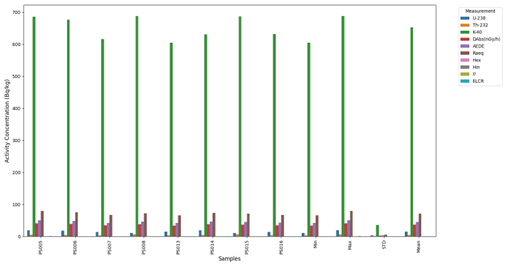Radioactivity Concentration in Quarry mining Soil in Pulka, Gwoza LGA, Borno State, Nigeria
Keywords:
Radioactivity, Gamma spectrometry, Radiological Hazard, Cancer, Pulka, GwozaAbstract
Effective monitoring of environmental radioactivity is essential for mitigating radiation-induced health risks such as cancer. In this study, the activity concentrations of 238U, 232Th, and 40K were measured in soil samples collected from seventeen sample points across gwoza local government area. Gamma-ray spectrometry was employed for the analysis conducted at the center for energy research and development, Obafemi Awolowo university Ile-Ife. Osun state. The results, obtained indicate average activity concentrations of approximately 14.01 Bq kg-1 for 238U, 3.19 Bq kg-1 for 232Th, and 571.72 Bq kg-1 for 40K, with 40K being the dominant contributor to the overall specific activity. Gamma hazard indices, were derived from the established equations. Furthermore, radiological parameters were evaluated, the Absorbed dose rate (DAbs), Annual Effective Dose (AEDE), Radium equivalent (Raeq), External hazard index (Hex), Internal hazard index (Hin), Gamma activity index (Iγr), and Excess lifetime cancer risk (ELCR). Were all determined to assess the radiation hazard of the quarry soil yielding average values of 32.17 nGyh-1, 0.0411 mSv y-1, 62.494 Bq kg-1, 0.168, 0.206, 0.506, and 0.000144 respectively, the current radiological concentration of the soil does not pose an immediate threat to human health or the environment. However, prolonged exposure over a lifetime could result to health risks for both workers and the general public, particularly for those in close proximity to the quarry. These findings underscore the importance of continuous radioactivity monitoring to protect both human health and other components of the locality.

Published
How to Cite
Issue
Section
Copyright (c) 2025 Journal of Science Research and Reviews

This work is licensed under a Creative Commons Attribution-NonCommercial 4.0 International License.
- Attribution — You must give appropriate credit, provide a link to the license, and indicate if changes were made. You may do so in any reasonable manner, but not in any way that suggests the licensor endorses you or your use.
- NonCommercial — You may not use the material for commercial purposes.
- No additional restrictions — You may not apply legal terms or technological measures that legally restrict others from doing anything the license permits.




